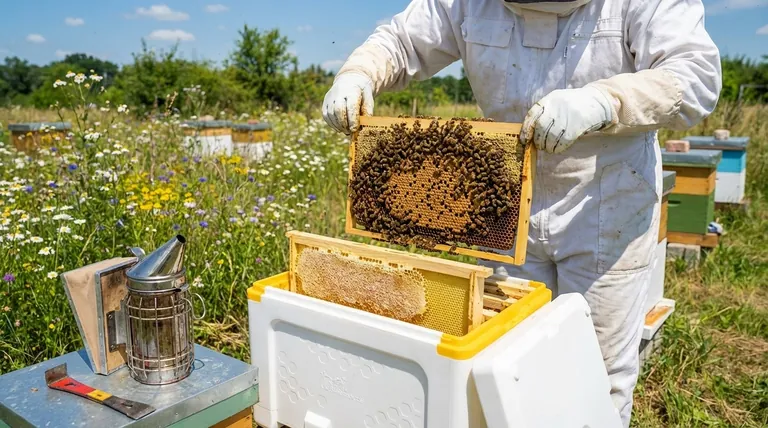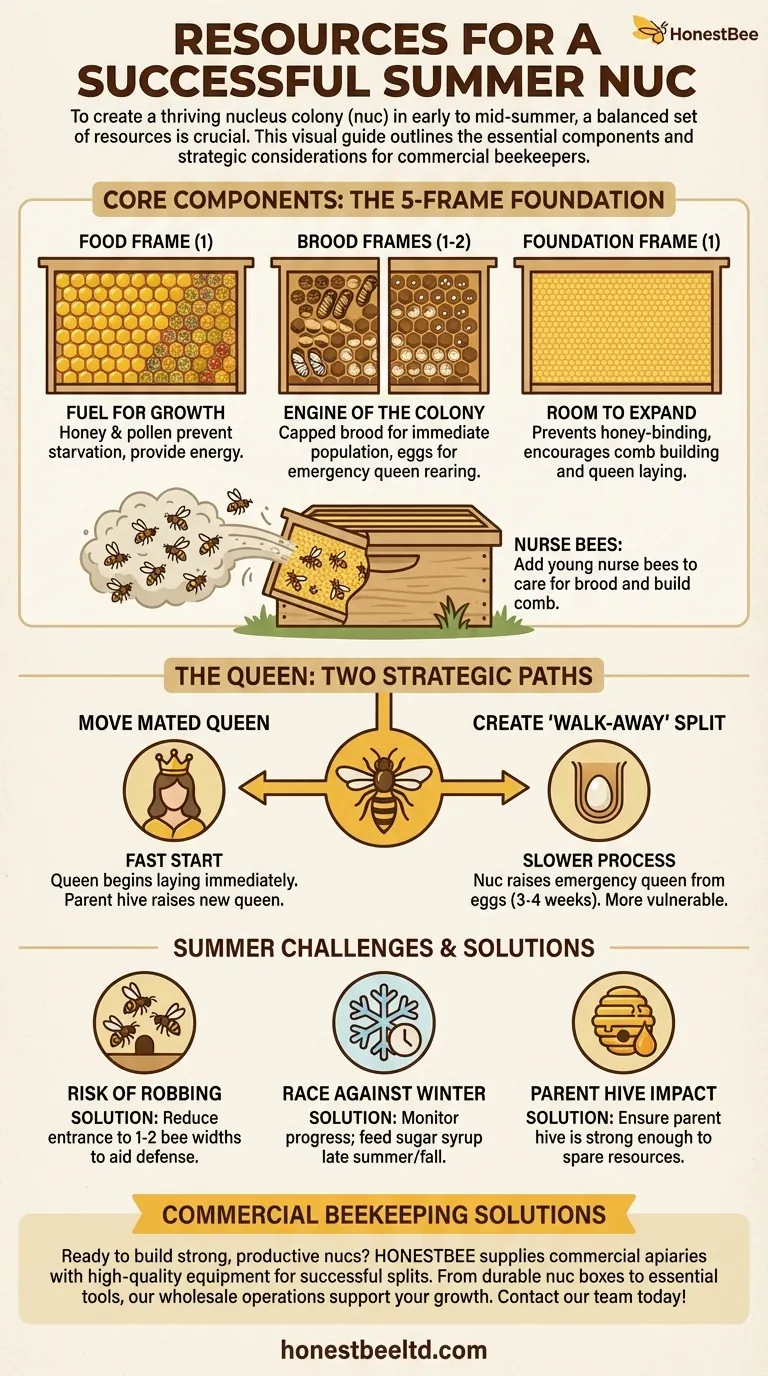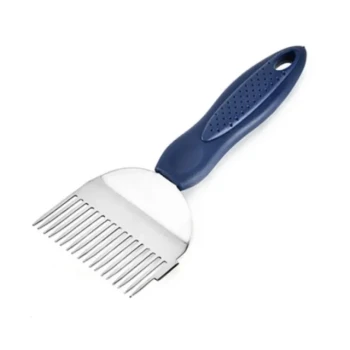To successfully create a nucleus colony (nuc) in early to mid-summer, you must provide it with a balanced set of resources. The core components are one to two frames of brood in all stages (eggs, open larvae, and capped pupae), one frame heavy with honey and pollen, and one frame of empty foundation for expansion. These frames, along with a population of nurse bees, form the foundation of a viable new colony.
A summer nuc isn't just a collection of frames; it's a self-sufficient starter hive. Your goal is to provide a balanced ecosystem with population, food, and room to grow, giving it the best possible chance to build up before winter.

Deconstructing the Essential Components
A successful split depends entirely on giving the new colony everything it needs to function independently from day one. Each component serves a distinct and critical purpose.
The Brood Frames: Engine of the New Colony
The brood frames are the heart of your new nuc. You need one to two frames containing a mix of all brood stages.
- Capped Brood: These are pupating bees ready to emerge. They provide a rapid, immediate population boost to the nuc, ensuring there are enough workers to perform all necessary tasks.
- Eggs & Young Larvae: The presence of eggs is non-negotiable. If you are not introducing a mated queen, the bees will use these fresh eggs to raise their own emergency queen.
- Open Larvae: These developing bees require feeding by nurse bees, which helps anchor the bee population to the nuc. They also produce pheromones that contribute to the colony's sense of stability.
The Food Frame: Fuel for Growth
A frame heavy with honey or nectar and, ideally, some pollen is the nuc's pantry. A new, small colony cannot forage effectively at first and is highly vulnerable to starvation.
This frame provides the immediate energy required for wax production, temperature regulation, and feeding the brood. Never create a nuc without a dedicated food source.
The Foundation Frame: Room to Expand
Including a frame of undrawn foundation or even an empty drawn comb gives the bees work to do and a place to grow. It provides space for the new queen to lay eggs or for foragers to store incoming nectar. This prevents the colony from becoming honey-bound and encourages healthy expansion.
The Missing Ingredient: The Bees
A nuc isn't just frames; it's a population. After placing your frames in the nuc box, you must shake in additional bees from one or two brood frames from the parent hive. You want to primarily add young nurse bees, as they are the ones who will care for the brood, draw out the foundation, and attend to the queen.
The Queen: Your Most Critical Decision
The references do not mention the queen, but this is the single most important decision you will make. You have two primary strategies.
Option 1: Move the Mated Queen
You can find the existing queen in the parent hive and move her into the nuc. This gives the nuc a significant head start, as she will begin laying eggs almost immediately. The original parent hive, now queenless but full of resources, will raise a new emergency queen.
Option 2: Create a "Walk-Away" Split
In this method, you create the nuc without the queen, ensuring it has frames with fresh eggs. The nuc will recognize its queenlessness and use those eggs to raise a new queen. This process takes much longer (around 3-4 weeks before the new queen is mated and laying), making the nuc more vulnerable for a period.
Understanding the Trade-offs of a Summer Split
Creating a nuc in spring is ideal. A summer split is possible but comes with unique challenges you must manage proactively.
The Risk of Robbing
In mid-summer, natural nectar sources can dwindle, creating a "dearth." During this time, stronger colonies may try to rob weaker ones. A small nuc is a prime target. Reduce the entrance of the nuc box to a tiny opening (1-2 bee widths) to make it easier for the small population to defend.
The Race Against Winter
A summer nuc has significantly less time to build its population and gather winter food stores compared to a spring split. You must monitor its progress closely and be prepared to feed it sugar syrup through the late summer and fall to ensure its survival.
Impact on the Parent Hive
Splitting a hive means removing resources—bees, brood, and honey. Doing this in summer can reduce the parent hive's potential honey surplus for the year. Assess the strength of the parent hive to ensure it can spare the resources without compromising its own winter preparations.
Making the Right Choice for Your Goal
Assembling the nuc correctly is vital. A standard five-frame nuc box should be arranged logically to protect the colony and encourage growth. A proven layout is to place the honey frame against an outer wall, followed by the two brood frames, and finally the foundation frame on the inside.
- If your primary focus is rapid expansion: Move the mated queen into the nuc for the fastest population growth, but be ready to support the now-queenless parent hive.
- If your primary focus is swarm control with minimal disruption: A walk-away split is a simple method, but you must accept that the nuc will take several weeks longer to become productive.
- If your primary focus is maximizing this year's honey harvest: Avoid a summer split entirely, as it diverts colony resources away from nectar collection and into raising new bees.
Thoughtful resource allocation is the difference between creating a thriving new colony and a struggling one.
Summary Table:
| Essential Resource | Purpose & Details |
|---|---|
| Brood Frames (1-2) | The colony's engine. Must include capped brood for immediate population, and eggs/larvae for queen rearing. |
| Food Frame | A dedicated honey/pollen frame to prevent starvation and fuel wax production and brood care. |
| Foundation Frame | An empty frame for expansion, providing space for the queen to lay and foragers to store nectar. |
| Nurse Bees | A shaken-in population of young bees to care for the brood, draw comb, and defend the nuc. |
Ready to build strong, productive nucs?
At HONESTBEE, we supply commercial apiaries and beekeeping equipment distributors with the high-quality supplies needed for successful splits. From durable nuc boxes to essential beekeeping tools, our wholesale-focused operations ensure you have the reliable equipment to support your colony expansion goals.
Let's discuss your beekeeping supply needs. Contact our team today!
Visual Guide

Related Products
- Automatic Heat Preservation 6 Frame Pro Nuc Box for Honey Bee Queen Mating
- 4 Frame Plastic Nuc Boxes for Beekeeping Bee Nuc Box
- HONESTBEE Professional Long Handled Hive Tool with Precision Cutting Blade
- HONESTBEE Advanced Ergonomic Stainless Steel Hive Tool for Beekeeping
- 5 Frame Langstroth Poly Nuc Corrugated Plastic Nuc Boxes
People Also Ask
- When should cells be distributed after setting up nucleus colonies? Ensure Queen Acceptance and Colony Success
- How many frames does a typical wooden nuc box hold? A Guide to Choosing the Right Size
- How can double nucs be expanded for additional frames? A Guide to Vertical Growth
- What are the two types of nucs? Choose the Right Nuc for Your Beekeeping Goals
- What is the process of making a nucleus in beekeeping? Master Sustainable Apiary Management



















